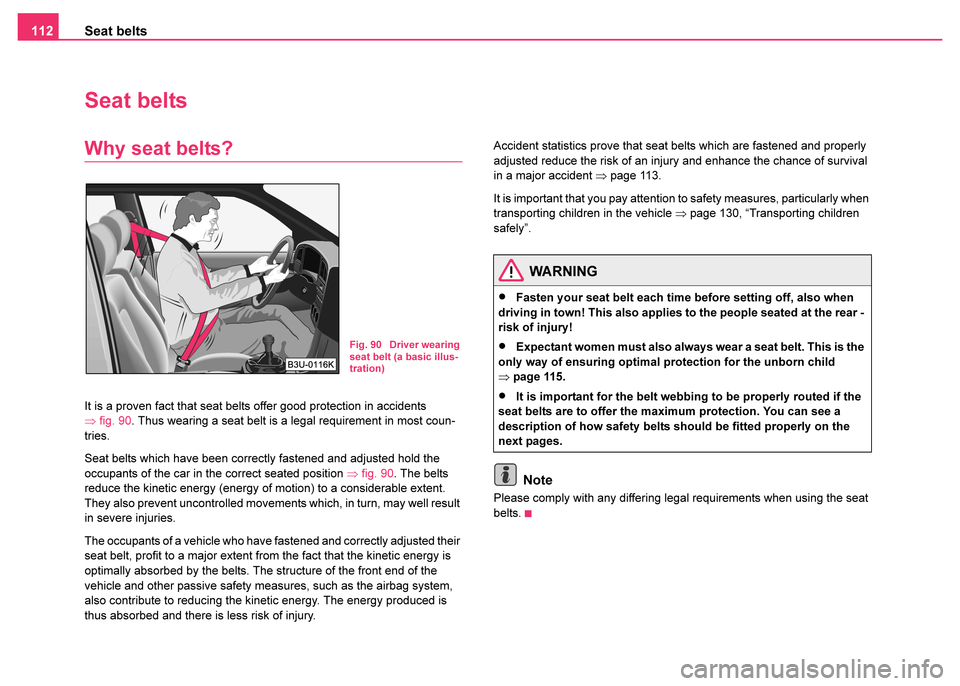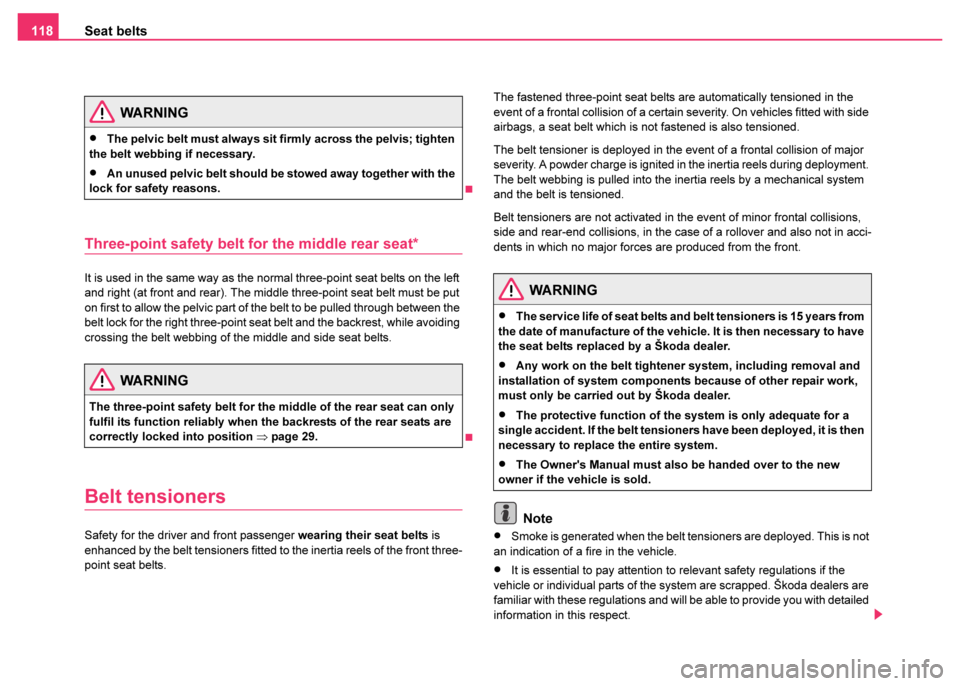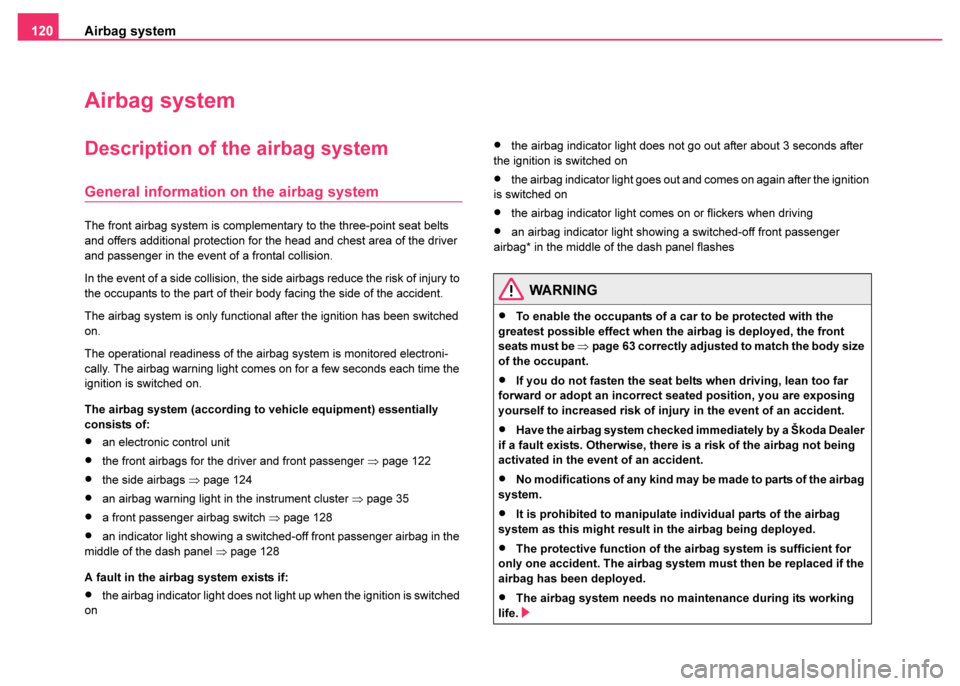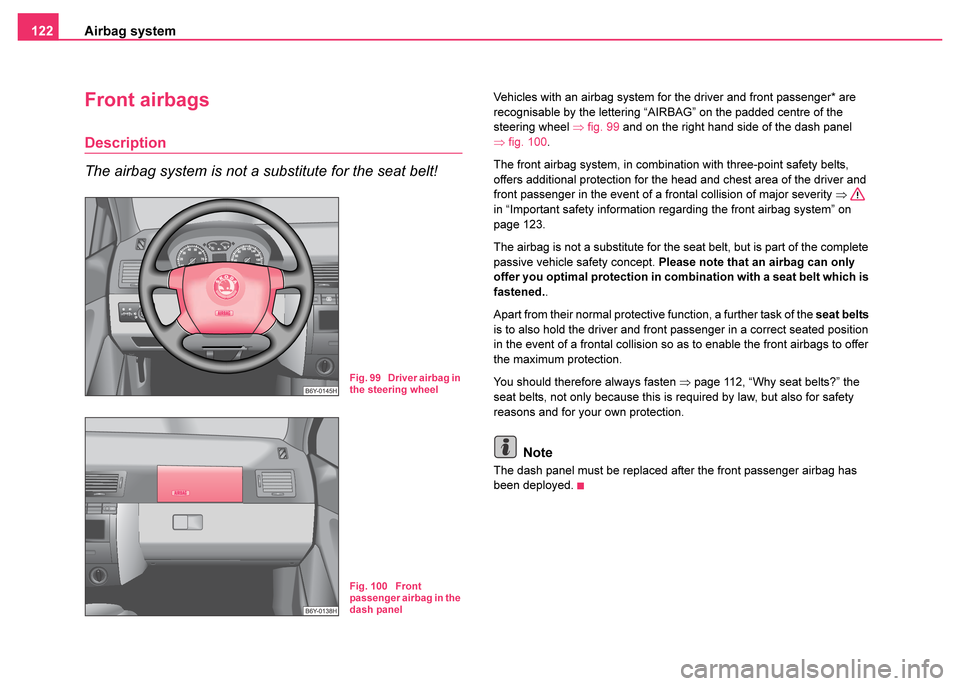2003 SKODA FABIA airbag
[x] Cancel search: airbagPage 65 of 233

Seats and Stowage
64
– Release the lever and push the seat further until the lock is heard to engage.
Adjusting height of seat*
– Lift the seat if required by pulling or pumping lever upwards.
– Lower the seat if required by pushing or pumping lever downwards.
Adjusting angle of backrest
– Relieve any pressure on the backrest (do not lean on it) and turn the handwheel to adjust the angle of the backrest.
The driver's seat should be adjusted in such a way that the pedals can be
pressed to the floor with slightly bent legs.
The backrest on the driver's seat should be adjusted in such a way that
the upper point of the steering wheel can be easily reached with slightly
bent arms.
Caution
Vehicles in the Praktik version should not experience contact between the
backrest and the partition wall after adjusting the angle of the backrest
since there is danger of damage to the seat cover through rubbing when
driving.
WARNING
•Only adjust the driver seat when the vehicle is stationary - risk
of injury!
•Take care when adjusting the seat! Adjusting the seat without
care can lead to bruises or injuries.
•The backrests must not be angled too far back when driving
otherwise this will affect proper operation of the seat belts and of
the airbag system - risk of injury!
A1
A2
A2
A3
Page 110 of 233

Communication109
Using the systemSafetyDriving TipsGeneral MaintenanceBreakdown assist-
anceTechnical DataFabia Praktik
Mobile phones and two-way radio
systems
The installation of mobile phones and two-way radio systems in a vehicle
should generally be undertaken by a Škoda dealer.
Škoda Auto permits the operation of mobile phones and two-way radio
systems with a professionally installed external aerial and a maximum
transmission power of up to 10 watts.
Our Škoda dealers are also happy to inform you about the possibilities
available for installing and operating mobile telephones and radio trans-
mitters which have an output greater than 10 watts. The Škoda dealers
can provide you with details about the technical possibilities for retrofitting
of mobile telephones and radio transmitters.
Operation of mobile phones or two-way radio systems may interfere with
functioning of the electronic systems of your vehicle. The reasons for this
may be:
•no external aerial
•external aerial incorrectly installed
•transmission power greater than 10 watts.
You should therefore not operate a mobile phone or two-way radio
system inside the vehicle without the use of an external aerial, or with
an external aerial which has been incorrectly installed.
You should also note that only an external aerial makes it possible to
achieve the optimal range of such equipment.
Note
Please also refer to the operating instructions of the mobile phones and
two-way radio systems.
The CD changer*
The CD changer for the car radio and navigation system is located under
the front passenger seat. A description of how to change the CD can be
found in the operating instructions for the CD changer.
WARNING
•If a mobile phone or two-way radio system is operated inside
the vehicle without using an external aerial, or with an external
aerial which has been incorrectly installed, the result can be exces-
sive electromagnetic fields which may cause harm to your health.
•Please always pay full attention to the traffic situation around
you!
•You must not install two-way radio systems, mobile phones or
mounts on the covers of the airbags or within the immediate
deployment range of airbags. This might result in injuries to the
occupants in the event of an accident.
Page 112 of 233

Passive Safety111
Using the systemSafetyDriving TipsGeneral MaintenanceBreakdown assist-
anceTechnical DataFabia Praktik
Safety
Passive Safety
Driving the safe way
Passive safety measures reduce the risk of injury in acci-
dent situations.
In this section you will find important information, tips and notes on the
subject of passive safety in your vehicle. We have combined everything
here which you should be familiar with, for example, regarding seat belts,
airbags, child seats and safety of children. It is therefore important, in
particular, to comply with the notes and warnings in this section for your
own interest and in the interest of all those travelling with you.
The information provided in this section applies to all models of your type
of vehicle. It is also possible that equipment is described here which does
not necessarily apply to your vehicle.
Requirements for maximum safety
It is important that you comply with the following requirements in order to
ensure that the seat belts and the airbag systems offer you and the occu-
pants of your vehicle maximum protection:
•front seats correctly adjusted ⇒page 63
•head restraints adjusted to match your body size ⇒page 65
•seat belts correctly fastened and adjusted ⇒page 115
•adopting a correct seated position
WARNING
Please do not forget to give the new owner the complete vehicle
documentation, if you sell your vehicle, including the service
schedule and documents relating to the possible deactivation of
airbags.
Page 113 of 233

Seat belts
112
Seat belts
Why seat belts?
It is a proven fact that seat belts offer good protection in accidents
⇒ fig. 90. Thus wearing a seat belt is a legal requirement in most coun-
tries.
Seat belts which have been correctly fastened and adjusted hold the
occupants of the car in the correct seated position ⇒fig. 90 . The belts
reduce the kinetic energy (energy of motion) to a considerable extent.
They also prevent uncontrolled movements which, in turn, may well result
in severe injuries.
The occupants of a vehicle who have fastened and correctly adjusted their
seat belt, profit to a major extent from the fact that the kinetic energy is
optimally absorbed by the belts. The structure of the front end of the
vehicle and other passive safety measures, such as the airbag system,
also contribute to reducing the kinetic energy. The energy produced is
thus absorbed and there is less risk of injury. Accident statistics prove that seat belts which are fastened and properly
adjusted reduce the risk of an injury and enhance the chance of survival
in a major accident
⇒page 113.
It is important that you pay attention to safety measures, particularly when
transporting children in the vehicle ⇒page 130, “Transporting children
safely”.
Note
Please comply with any differing legal requirements when using the seat
belts.
Fig. 90 Driver wearing
seat belt (a basic illus-
tration)
WARNING
•Fasten your seat belt each time before setting off, also when
driving in town! This also applies to the people seated at the rear -
risk of injury!
•Expectant women must also always wear a seat belt. This is the
only way of ensuring optimal protection for the unborn child
⇒ page 115.
•It is important for the belt webbing to be properly routed if the
seat belts are to offer the maximum protection. You can see a
description of how safety belts should be fitted properly on the
next pages.
Page 119 of 233

Seat belts
118
Three-point safety belt for the middle rear seat*
It is used in the same way as the normal three-point seat belts on the left
and right (at front and rear). The middle three-point seat belt must be put
on first to allow the pelvic part of the belt to be pulled through between the
belt lock for the right three-point seat belt and the backrest, while avoiding
crossing the belt webbing of the middle and side seat belts.
Belt tensioners
Safety for the driver and front passenger wearing their seat belts is
enhanced by the belt tensioners fitted to the inertia reels of the front three-
point seat belts. The fastened three-point seat belts are automatically tensioned in the
event of a frontal collision of a certain severity. On vehicles fitted with side
airbags, a seat belt which is not fastened is also tensioned.
The belt tensioner is deployed in the event of a frontal collision of major
severity. A powder charge is ignited in the inertia reels during deployment.
The belt webbing is pulled into the inertia reels by a mechanical system
and the belt is tensioned.
Belt tensioners are not activated in the event of minor frontal collisions,
side and rear-end collisions, in the case of a rollover and also not in acci-
dents in which no major forces are produced from the front.
Note
•Smoke is generated when the belt tensioners are deployed. This is not
an indication of a fire in the vehicle.
•It is essential to pay attention to relevant safety regulations if the
vehicle or individual parts of the system are scrapped. Škoda dealers are
familiar with these regulations and will be able to provide you with detailed
information in this respect.
WARNING
•The pelvic belt must always sit firmly across the pelvis; tighten
the belt webbing if necessary.
•An unused pelvic belt should be stowed away together with the
lock for safety reasons.
WARNING
The three-point safety belt for the middle of the rear seat can only
fulfil its function reliably when the backrests of the rear seats are
correctly locked into position ⇒page 29.
WARNING
•The service life of seat belts and belt tensioners is 15 years from
the date of manufacture of the vehicle. It is then necessary to have
the seat belts replaced by a Škoda dealer.
•Any work on the belt tightener system, including removal and
installation of system components because of other repair work,
must only be carried out by Škoda dealer.
•The protective function of the system is only adequate for a
single accident. If the belt tensioners have been deployed, it is then
necessary to replace the entire system.
•The Owner's Manual must also be handed over to the new
owner if the vehicle is sold.
Page 121 of 233

Airbag system
120
Airbag system
Description of the airbag system
General information on the airbag system
The front airbag system is complementary to the three-point seat belts
and offers additional protection for the head and chest area of the driver
and passenger in the event of a frontal collision.
In the event of a side collision, the side airbags reduce the risk of injury to
the occupants to the part of their body facing the side of the accident.
The airbag system is only functional after the ignition has been switched
on.
The operational readiness of the airbag system is monitored electroni-
cally. The airbag warning light comes on for a few seconds each time the
ignition is switched on.
The airbag system (according to vehicle equipment) essentially
consists of:
•an electronic control unit
•the front airbags for the driver and front passenger ⇒page 122
•the side airbags ⇒ page 124
•an airbag warning light in the instrument cluster ⇒page 35
•a front passenger airbag switch ⇒page 128
•an indicator light showing a switched-off front passenger airbag in the
middle of the dash panel ⇒ page 128
A fault in the airbag system exists if:
•the airbag indicator light does not light up when the ignition is switched
on
•the airbag indicator light does not go out after about 3 seconds after
the ignition is switched on
•the airbag indicator light goes out and comes on again after the ignition
is switched on
•the airbag indicator light comes on or flickers when driving
•an airbag indicator light showing a switched-off front passenger
airbag* in the middle of the dash panel flashes
WARNING
•To enable the occupants of a car to be protected with the
greatest possible effect when the airbag is deployed, the front
seats must be ⇒ page 63 correctly adjusted to match the body size
of the occupant.
•If you do not fasten the seat belts when driving, lean too far
forward or adopt an incorrect seated position, you are exposing
yourself to increased risk of injury in the event of an accident.
•Have the airbag system checked immediately by a Škoda Dealer
if a fault exists. Otherwise, there is a risk of the airbag not being
activated in the event of an accident.
•No modifications of any kind may be made to parts of the airbag
system.
•It is prohibited to manipulate individual parts of the airbag
system as this might result in the airbag being deployed.
•The protective function of the airbag system is sufficient for
only one accident. The airbag system must then be replaced if the
airbag has been deployed.
•The airbag system needs no maintenance during its working
life.
Page 122 of 233

Airbag system121
Using the systemSafetyDriving TipsGeneral MaintenanceBreakdown assist-
anceTechnical DataFabia Praktik
When are the airbags deployed?
The airbag system is designed in such a way that the driver and the front
passenger airbag* are deployed in the event of a frontal collision of
major severity.
In the case of a violent side crash the side airbags* on the front seat of
the vehicle on the side on which the collision occurs are deployed.
It is also possible under certain special accident situations that the front
as well as the side airbags are deployed.
The airbags are not deployed in the case of minor frontal and side colli-
sions, in the case of rear-end collisions and vehicle rollover.
Deployment factors
It is not possible to state globally which deployment conditions apply to the
airbag system in every situation as the circumstances which exist in the
case of accidents vary greatly. An important role in this case, for example, is played by factors such as the type of object against which the vehicle
impacts (hard, soft), the angle of impact, the vehicle speed etc.
A decisive factor for the deployment of the airbags is the deceleration
which occurs during a collision. The control unit analyses the nature of the
collision and activates the relevant restraint system. If the vehicle decel-
eration which occurs and is measured during the collision remains below
the prescribed reference values specified in the control unit, the airbags
are not deployed although the vehicle may well suffer severe damage to
the bodywork as a consequence of the accident.
The airbags are not deployed if:
•ignition off
•a minor frontal collision
•a minor side collision
•a rear-end collision
•rollover
Note
•A fine dust is produced when airbag inflated. This is perfectly normal
and is not an indication of a fire in the vehicle.
•The dash panel must be replaced after the front passenger airbag has
been deployed.
WARNING (continued)
•The service life of the airbag system is 15 years from the date of
manufacture of the vehicle. Have the airbag system replaced by a
Škoda Dealer after this period.
•If you sell your car, please hand over the complete vehicle
documentation to the new owener. Please note that the documents
relating to the possibility of deactivating the front passenger
airbag are also part of the vehicle documents!
•If the vehicle or individual parts of the airbag system are
scrapped, it is essential to observe the relevant safety precautions.
Škoda dealers are familiar with these regulations.
•When disposing of vehicle or parts of the airbag system, it is
important to comply with the national legal requirements.
Page 123 of 233

Airbag system
122
Front airbags
Description
The airbag system is not a substitute for the seat belt!
Vehicles with an airbag system for the driver and front passenger* are
recognisable by the lettering “AIRBAG” on the padded centre of the
steering wheel ⇒ fig. 99 and on the right hand side of the dash panel
⇒ fig. 100 .
The front airbag system, in combination with three-point safety belts,
offers additional protection for the head and chest area of the driver and
front passenger in the event of a frontal collision of major severity ⇒
in “Important safety information regarding the front airbag system” on
page 123.
The airbag is not a substitute for the seat belt, but is part of the complete
passive vehicle safety concept. Please note that an airbag can only
offer you optimal protection in combination with a seat belt which is
fastened. .
Apart from their normal protective function, a further task of the seat belts
is to also hold the driver and front passenger in a correct seated position
in the event of a frontal collision so as to enable the front airbags to offer
the maximum protection.
You should therefore always fasten ⇒ page 112, “Why seat belts?” the
seat belts, not only because this is required by law, but also for safety
reasons and for your own protection.
Note
The dash panel must be replaced after the front passenger airbag has
been deployed.
Fig. 99 Driver airbag in
the steering wheel
Fig. 100 Front
passenger airbag in the
dash panel